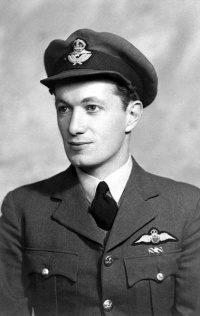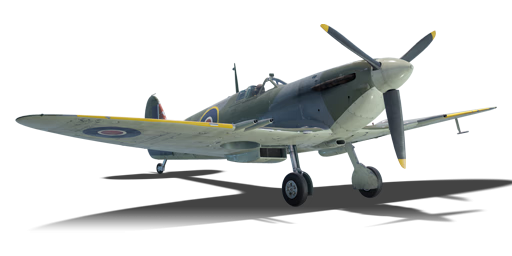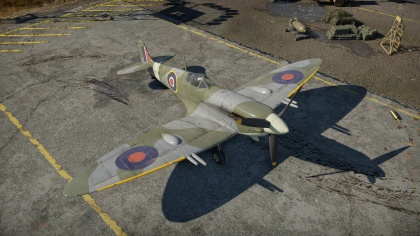Difference between revisions of "Spitfire Mk Vc"
(gameplay, pros/cons, commented out placeholder text.) (Tag: Visual edit) |
(→Usage in battles: Edits) |
||
| Line 141: | Line 141: | ||
== Usage in battles == | == Usage in battles == | ||
<!-- Describe the tactics of playing in an aircraft, the features of using vehicles in a team and advice on tactics. Refrain from creating a "guide" - do not impose a single point of view, but instead, give the reader food for thought. Examine the most dangerous enemies and give recommendations on fighting them. If necessary, note the specifics of the game in different modes (AB, RB, SB). --> | <!-- Describe the tactics of playing in an aircraft, the features of using vehicles in a team and advice on tactics. Refrain from creating a "guide" - do not impose a single point of view, but instead, give the reader food for thought. Examine the most dangerous enemies and give recommendations on fighting them. If necessary, note the specifics of the game in different modes (AB, RB, SB). --> | ||
| − | The Spitfire Mk Vc does not have as high a climb rate as other Spitfires, but it does make up for this in manoeuvrability and firepower. Like all Spitfires, this one is a very good at turning with nearly any opponent that it might face. Trying to lure the enemy into extended turnfights is one of the most effective tactics to use in this plane. Thanks to a decent straight-line energy retention, the plane can also boom and zoom fairly well. However, keep in mind that control surfaces do suffer from compression at high speeds. Roll rate is dramatically reduced above 600 | + | The Spitfire Mk Vc does not have as high a climb rate as other Spitfires, but it does make up for this in manoeuvrability and firepower. Like all Spitfires, this one is a very good at turning with nearly any opponent that it might face. Trying to lure the enemy into extended turnfights is one of the most effective tactics to use in this plane. Thanks to a decent straight-line energy retention, the plane can also boom and zoom fairly well. However, keep in mind that control surfaces do suffer from compression at high speeds. Roll rate is dramatically reduced above 600 km/h, and elevator authority similarly suffers above 700 km/h. This can make it difficult to get guns on target in high-speed boom and zoom runs. |
| − | As for firepower, this vehicle is armed with 4 20 mm cannons. Being wing-mounted, convergence is important for these guns, but they can do considerable damage if they connect. It is recommended to set a convergence of 300-400 m, and to hold fire unless at these close ranges. | + | As for firepower, this vehicle is armed with 4 x 20 mm cannons. Being wing-mounted, convergence is important for these guns, but they can do considerable damage if they connect. It is recommended to set a convergence of 300-400 m, and to hold fire unless at these close ranges. |
The Mk Vc's engine has high fuel consumption when using WEP. So, it is important to keep an eye on remaining fuel levels, and on certain maps it may be necessary to take high fuel loads. | The Mk Vc's engine has high fuel consumption when using WEP. So, it is important to keep an eye on remaining fuel levels, and on certain maps it may be necessary to take high fuel loads. | ||
| − | In a straight line, the | + | In a straight line, the Spitfire's top speed cannot compete with many of its American and Russian counterparts. You may sometimes find yourself being chased down by faster aircraft, and in these scenarios the best thing to do is either to look for teammates to back you up or to try luring them gradually into a turnfight. |
=== Manual Engine Control === | === Manual Engine Control === | ||
Revision as of 07:33, 20 July 2020
Contents
| This page is about the British fighter Spitfire Mk Vc. For the tropical version, see Spitfire Mk Vc/trop. For other uses, see Spitfire (Family). |
Description
The Spitfire Mk Vc is a rank III British fighter
with a battle rating of 5.7 (AB) and 5.0 (RB/SB). This fighter was introduced in Update 1.77 "Advancing Storm".
General info
Flight Performance
| Characteristics | |||||||
|---|---|---|---|---|---|---|---|
| Stock | |||||||
| Max Speed (km/h at 3,963 m) |
Max altitude (meters) |
Turn time (seconds) |
Rate of climb (meters/second) |
Take-off run (meters) | |||
| AB | RB | AB | RB | AB | RB | ||
| 577 | 558 | 10500 | 17.2 | 17.8 | 14.6 | 14.6 | 340 |
| Upgraded | |||||||
| Max Speed (km/h at 3,963 m) |
Max altitude (meters) |
Turn time (seconds) |
Rate of climb (meters/second) |
Take-off run (meters) | |||
| AB | RB | AB | RB | AB | RB | ||
| 643 | 602 | 10500 | 15.8 | 16.2 | 27.3 | 19.7 | 340 |
Details
| Features | ||||
|---|---|---|---|---|
| Combat flaps | Take-off flaps | Landing flaps | Air brakes | Arrestor gear |
| X | X | ✓ | X | X |
| Limits | ||||
|---|---|---|---|---|
| Wing-break speed (km/h) |
Gear limit (km/h) |
Combat flaps (km/h) |
Max Static G | |
| + | - | |||
| 760 | 270 | 290 | ~10 | ~5 |
| Optimal velocities | |||
|---|---|---|---|
| Ailerons (km/h) |
Rudder (km/h) |
Elevators (km/h) |
Radiator (km/h) |
| < 321 | < 400 | < 350 | > 450 |
| Compressor (RB/SB) | ||
|---|---|---|
| Setting 1 | ||
| Optimal altitude | 100% Engine power | WEP Engine power |
| 3,800 m | 1,200 hp | 1,704 hp |
Survivability and armour
- 38 mm Bulletproof glass - Armoured windscreen
- 4 mm Steel - Armoured pilot's seat, coupled with another
- 7mm Steel - Behind the pilot's seat
- 6mm Steel - Behind the pilot's head
- 3 mm Steel - Armoured plate in front of engine above propeller
- 1 mm Steel - Armoured plate in front of front top fuel tank
- 3 mm Steel - Armoured plates around ammunition
Armaments
Offensive armament
The Spitfire Mk Vc is armed with:
- 4 x 20 mm Hispano Mk.II cannons, wing-mounted (120 rpg = 480 total)
Usage in battles
The Spitfire Mk Vc does not have as high a climb rate as other Spitfires, but it does make up for this in manoeuvrability and firepower. Like all Spitfires, this one is a very good at turning with nearly any opponent that it might face. Trying to lure the enemy into extended turnfights is one of the most effective tactics to use in this plane. Thanks to a decent straight-line energy retention, the plane can also boom and zoom fairly well. However, keep in mind that control surfaces do suffer from compression at high speeds. Roll rate is dramatically reduced above 600 km/h, and elevator authority similarly suffers above 700 km/h. This can make it difficult to get guns on target in high-speed boom and zoom runs.
As for firepower, this vehicle is armed with 4 x 20 mm cannons. Being wing-mounted, convergence is important for these guns, but they can do considerable damage if they connect. It is recommended to set a convergence of 300-400 m, and to hold fire unless at these close ranges.
The Mk Vc's engine has high fuel consumption when using WEP. So, it is important to keep an eye on remaining fuel levels, and on certain maps it may be necessary to take high fuel loads.
In a straight line, the Spitfire's top speed cannot compete with many of its American and Russian counterparts. You may sometimes find yourself being chased down by faster aircraft, and in these scenarios the best thing to do is either to look for teammates to back you up or to try luring them gradually into a turnfight.
Manual Engine Control
| MEC elements | ||||||
|---|---|---|---|---|---|---|
| Mixer | Pitch | Radiator | Supercharger | Turbocharger | ||
| Oil | Water | Type | ||||
| Controllable | Controllable Not auto controlled |
Not controllable Auto control available |
Controllable Not auto controlled |
Separate | Not controllable 1 gear |
Not controllable |
Modules
| Tier | Flight performance | Survivability | Weaponry | |
|---|---|---|---|---|
| I | Fuselage repair | Radiator | Offensive 20 mm | |
| II | Compressor | Airframe | New 20 mm cannons | |
| III | Wings repair | Engine | Mk.II year 1942 | |
| IV | Engine injection | Cover | Mk.II year 1943 | |
Pros and cons
Pros:
- Excellent turn rate
- Low top speed
- Higher than average acceleration
Cons:
- Low ammo count
- Poor climb rate compared to other Spitfires
- High fuel consumption when using WEP
History
In-game description
"A single-seat, single-engine all-metal monoplane fighter, this variant of the Spitfire Mk V was fitted with the new Type C “universal” wing, capable of being fitted with a variety of armaments. The Mk VC could be fitted with four 20mm Hispano cannons, or it could carry two 20mm Hispano cannons and four 0.303 inch Colt-Browning Mk II machine guns. The cannons in the type C wings had a tape supply and so could carry up to 120 rounds per gun, unlike the type B wings, which were limited to 60 rounds. In addition, the Mk VC had other modifications to the airframe such as a strengthened fuselage, more armor, larger oil cooler and a new windscreen design.
Production of the Mk VC variant began in October of 1941, with the first aircraft being equipped with a Rolls Royce Merlin 45 or 46. However, with the appearance of the German Focke-Wulf FW190 fighter, Spitfire pilots found themselves being outmanoeuvred at low and medium altitudes.
The Mk VC was then fitted with Merlin 50, 50A, 55, and 56 engines. To improve performance characteristics at low and medium altitudes, some of these engines were fitted with a cropped supercharger impeller to allow maximum power to be reached at lower altitudes. Engines designed this way included the 45M, 50M, and 55M.
On the lower altitude models, further changes were implemented. To reduce drag and moment of inertia on the aircraft's longitudinal axis, the wingspan was reduced and the elliptical wingtips were redesigned to be nearly rectangular. Fighters designed with low-altitude combat in mind were designated Spitfire LFMk Vs (Low Flight). Aircraft optimized for mid-altitude combat were designated Spitfire FMk Vs (Flight) and fighters fitted with the Merlin 46, 50A, or 56 were designated Spitfire HFMk Vs (High Flight) and had an increased wingspan with elongated, elliptical wingtips.
The Spitfire VC fought in all theatres in which the RAF was active from 1941 to 1944. A total of some 6,500 Spitfire Mk V fighters were produced, of which 2,467 were Mk VCs."
Notable pilots
-
 Top scoring Southern Rhodesian ace pilot John Plagis and highest scoring pilot of Greek origin of WW II. Plagis flew the Spitfire Mk Vc as bomber escort over Europe.
Top scoring Southern Rhodesian ace pilot John Plagis and highest scoring pilot of Greek origin of WW II. Plagis flew the Spitfire Mk Vc as bomber escort over Europe.
Media
Excellent additions to the article would be video guides, screenshots from the game, and photos.
See also
Links to the articles on the War Thunder Wiki that you think will be useful for the reader, for example:
- reference to the series of the aircraft;
- links to approximate analogues of other nations and research trees.
External links
| Supermarine | |
|---|---|
| Spitfires | |
| Merlin engine | Spitfire Mk Ia · Spitfire Mk IIa · Spitfire Mk.IIa Venture I · Spitfire Mk IIb |
| Spitfire Mk Vb · Spitfire Mk Vb/trop · Spitfire Mk Vc · Spitfire Mk Vc/trop | |
| Spitfire F Mk IX · Spitfire F Mk IXc · Spitfire F Mk XVI | |
| Spitfire LF Mk IX · Plagis' Spitfire LF Mk IXc | |
| Griffon engine | Spitfire F Mk XIVc · Spitfire F Mk XIVe · Prendergast's Spitfire FR Mk XIVe · Spitfire F Mk XVIIIe · Spitfire F Mk 22 · Spitfire F Mk 24 |
| Export | ▄Spitfire Mk Vb/trop · ▃Spitfire LF Mk IXc · ▂Spitfire Mk IXc · Spitfire Mk IXc · Spitfire Mk.IX (CW) · Weizman's Spitfire LF Mk.IXe · ▄Spitfire FR Mk XIVe |
| Seafires | Seafire LF Mk.III · Seafire F Mk XVII · Seafire FR 47 |
| Export | ▄Seafire LF Mk.III |
| Jet fighters | Attacker FB 1 · Attacker FB.2 · Scimitar F Mk.1 · Swift F.1 · Swift F.7 |
| Hydroplanes | Walrus Mk.I |





